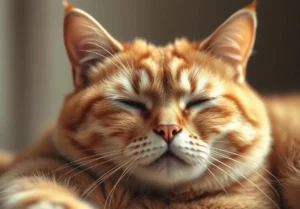Cats have a remarkable ability to squeeze into the tiniest of spaces, leaving many owners in awe of their flexibility and agility. But why exactly are cats able to contort their bodies in such a way? Let’s delve into the fascinating reasons behind this unique feline behavior.
Anatomy of a Cat’s Body
Cats have some pretty incredible physical features that make them masters of squeezing into tight spaces. First off, their flexible spines are like built-in slinkies, allowing them to contort and twist into all kinds of positions. Additionally, cats have collapsible rib cages, which means they can compress their bodies to fit through narrow openings, kind of like a furry accordion. And let’s not forget about their strong muscles, especially in their shoulders and hips, which give them the power to push and pull their way into those cozy little nooks and crannies around your home.
Hunting Instincts at Play
It’s not just their bendy bodies that help cats slide into small spaces—it’s also their natural hunting instincts. See, back in the wild, cats would use their stealth and agility to sneak up on unsuspecting prey. By being able to squeeze into tight spots, they can hide and wait for the perfect moment to pounce on their target. So, when you see your cat disappearing into a tiny gap in the furniture, just know they’re channeling their inner hunter, ready to strike at any moment.
- And here’s a pro tip: providing your cat with plenty of enriching toys and interactive playtime can help satisfy their hunting instincts and keep them mentally stimulated, reducing the temptation to explore every nook and cranny in your home.
Evolutionary Adaptations
Cats’ ability to squeeze into small spaces is a result of their remarkable evolutionary adaptations. In the wild, cats have had to navigate various challenges to survive, such as seeking shelter from predators or extreme weather conditions. Their flexible bodies and agile nature have allowed them to escape danger by slipping into tight spots where larger predators can’t reach. Over time, this behavior has become ingrained in their survival instincts, making them masters of fitting into confined spaces for safety and security.
Comfort and Security
When your cat curls up in a cozy cardboard box or squeezes into a small nook, it’s not just about finding a snug spot—it’s about seeking comfort and security. These small spaces provide a sense of warmth and protection that mimic the security of a mother cat’s embrace. The enclosed environment offers a feeling of safety and control, helping cats reduce stress and anxiety. It’s their way of creating a personal sanctuary where they can rest and recharge, away from the hustle and bustle of the world.
Unique Insight: Cats also seek out small spaces as a way to conserve body heat. Their natural body temperature is higher than humans, so cozying up in a small space helps them retain heat and stay warm, especially in cooler environments.
Remember, when your feline friend is tucked away in a tiny corner or nestled in a tight space, it’s not just about fitting in—they’re finding solace and peace in their own little world.
Acrobatic Skills
Cats are nature’s little gymnasts, equipped with incredible flexibility and agility that allow them to contort their bodies in impressive ways. Their bones are highly flexible, and they have an exceptional collarbone that isn’t connected to other bones, granting them the ability to squeeze through tight spots like champs. Their powerful hind legs provide the necessary thrust to propel them into small openings, while their sharp claws help them grip onto surfaces for better leverage. It’s like having your own personal feline superhero ready to tackle any narrow path or cramped space!
Key Insight: Cats have a unique skeletal structure that enables them to twist, turn, and squeeze themselves into the smallest of spaces, showcasing their remarkable acrobatic abilities.
Curiosity and Exploration
Curiosity may have famously “killed the cat,” but it also drives them to find out what’s lurking in that mysterious box or what treasures may be hidden under the bed. A cat’s innate curiosity compels them to investigate every nook and cranny, making them natural explorers of the hidden realms in your home. This unrelenting need for discovery leads them to squeeze into the tiniest of spaces, as they are always on the lookout for new adventures and peculiar spots to claim as their own.
Key Insight: Cats’ insatiable curiosity fuels their desire to explore every corner, no matter how tight, propelling them to venture into small spaces in search of new experiences.
- Cramped Comfort: Cats also seek out snug spaces for a sense of security and warmth, as tight quarters offer a cozy retreat from the hustle and bustle of the household.
- Hunting Instinct: Cats’ natural hunting instincts drive them to seek out secluded spots resembling potential prey hideouts, prompting them to squeeze into small spaces to stalk their “prey.”
Unique Behaviors in Different Breeds
When it comes to cats squeezing into small spaces, some breeds have unique characteristics that make them more inclined to do so. For instance, breeds like the Siamese, Abyssinian, and Sphynx are known for their curiosity and agility, which drive them to explore tight spots. These breeds have a higher likelihood of exhibiting the behavior due to their natural inquisitiveness and flexibility. On the other hand, larger or more laid-back breeds may not show the same level of interest in squeezing into small spaces.
Breed-specific Insights: 1. Siamese: These cats are exceptionally agile and love to climb, making them more likely to tuck themselves into cozy corners. 2. Abyssinian: Known as one of the most active cat breeds, Abyssinians enjoy investigating nooks and crannies, even if it means squeezing through tight openings. 3. Sphynx: Despite their lack of fur, Sphynx cats have muscular bodies that allow them to contort and fit into small spaces with ease.
Providing ample enrichment and hiding spots tailored to your cat’s breed can help satisfy their natural instincts while keeping them safe and comfortable.
Safety Precautions for Cat Owners
Creating a safe environment for your feline friend is crucial when it comes to their penchant for squeezing into small spaces. To ensure their well-being while indulging this behavior, consider the following safety precautions:
- Limit Access to Dangerous Areas: Block off spaces like vents, cupboards, and small openings that could pose a risk to your cat.
- Provide Proper Ventilation: If your cat loves cozying up in tight spots, make sure there is adequate airflow to prevent overheating.
- Regularly Check Hiding Spots: Inspect potential hiding spots to ensure your cat is not stuck or in distress.
- Avoid Hazardous Materials: Keep toxic substances, small objects, and dangling cords out of reach to prevent accidents.
By incorporating these safety measures into your home, you can create a secure environment that allows your cat to enjoy their natural behaviors without compromising their well-being.
Fun Facts about Cats and Small Spaces
Cats are known for their uncanny ability to squeeze into the tiniest of spaces, often leaving us wondering how they manage to fit into such tight spots. This quirky behavior is actually rooted in their evolutionary history. Cats are natural predators, and their ancestors needed to be able to hunt in a variety of environments, including tight spaces like crevices and burrows. The flexibility and agility that allow them to squeeze into small spaces are remnants of this hunting instinct passed down through generations.
Another fascinating fact about cats and small spaces is that they have a unique skeletal structure that enables their contortionist-like movements. Cats have collarbones that are not connected to other bones, giving them greater flexibility to twist and turn their bodies. Their vertebrae are also incredibly flexible, allowing them to flatten themselves out and contort into compact shapes to fit into cramped spaces.
Cats also have a strong desire for security and comfort, which drives them to seek out small, enclosed spaces. These cozy nooks provide a sense of safety and protection, much like a den in the wild. So next time you spot your feline friend squeezing into a box or curling up in a tight corner, remember that it’s not just about fitting into small spaces—it’s about finding a sense of security and comfort in their surroundings.
Alex, a passionate animal lover, has experience in training and understanding animal behavior. As a proud pet parent to two dogs and three cats, he founded AnimalReport.net to share insights from animal experts and expand his knowledge of the animal kingdom.




